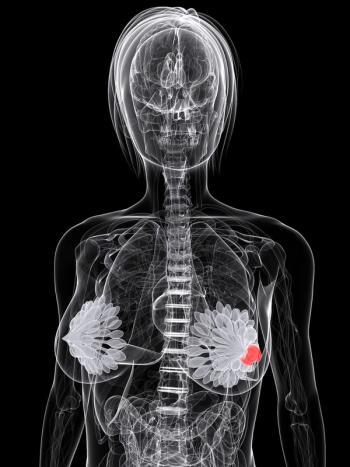
Enzalutamide Plus Androgen Deprivation Therapy Demonstrates Durable Overall Survival Benefit in mHSPC
Men with metastatic hormone-sensitive prostate cancer who were treated with enzalutamide plus androgen deprivation therapy experienced an improved, long-lasting overall survival compared with those who received placebo.
Treatment with enzalutamide (Xtandi) and androgen deprivation therapy (ADT) yielded a durable overall survival (OS) benefit in men with metastatic hormone-sensitive prostate cancer (mHSPC), according to data from the phase 3 ARCHES study (NCT02677896) that were presented at the
At 24 months, 86% of patients were alive in the enzalutamide group compared with 82% in the placebo group. Moreover, at 36 months, 78% of those in the enzalutamide cohort were alive vs 69% in the placebo group. Lastly, at 48 months, there were 71% were alive in the enzalutamide group compared with 57% in the placebo group. The enzalutamide group achieved a significantly improved OS by 34% compared with the placebo group.
The trial had a median follow up of 44.6 months, and a median treatment duration of 40.2 months in the enzalutamide plus ADT cohort, 13.8 months for those in the placebo plus ADT cohort, and 23.9 months for those who crossed over. The enzalutamide plus ADT group had an extended survival compared with the placebo plus ADT group (HR, 0.66; 95% CI, 0.53-0.81; P <.0001).
“The early use of enzalutamide with ADT led to a significant delay in the need for subsequent antineoplastic therapy,” Andrew J. Armstrong MD, MSc, a medical oncologist at Duke University said during a presentation on the study.
The study enrolled 1150 men who were randomized 1:1 to receive either 160 mg of enzalutamide plus ADT (n = 574) or placebo plus ADT (n = 576).
In addition to having mHSPC confirmed via bone scan, CT, or MRI, patients also needed to have histologically confirmed adenocarcinoma. An ECOG status of 0 to 1 was also required, as well as a current ADT duration of 3 months or less in the metastatic setting; for those who have received prior docetaxel, a duration of 6 months or less was allowed. Patients were stratified based on volume of disease and prior docetaxel therapy for mHSPC.
The study’s end points included OS, time to subsequent antineoplastic therapy, and safety.
The study was unblinded during final analysis to let those patients still enrolled to continue treatment. At the time of unblinding, 31.9% (n = 184) of patients in the placebo group were progression-free and consented to cross over to the enzalutamide group. Of these patients, 31.3% (n = 180) received treatment with enzalutamide plus ADT. The median time to crossover was 21.5 months.
At the time of data cutoff (May 28, 2021), 356 patients had died, including 154 from the enzalutamide group and 202 from the placebo group. Patients remained on the placebo crossover for a median of 23.9 months. Enzalutamide delayed the risk of death over time by.
Investigators also assessed the time to subsequent antineoplastic therapy and reported that those receiving enzalutamide had a significant delay in the need for subsequent therapy (HR, 0.38; 95% CI, 0.31-0.48). A total of 8.4% (n = 48) of patients in the enzalutamide group and 12.3% (n = 71) of those in the placebo group received treatment docetaxel. Patients in the enzalutamide and placebo arms, respectively, also received subsequent treatment with abiraterone (Zytiga; 4.5% vs 7.3%), enzalutamide (1.2% vs 10.6%), bicalutamide (Casodex)/flutamide (Eulexin; 1.4% vs 4.0%), cabazitaxel (Jevtana; 1.9% vs 1.0%), sipuleucel-T (Provenge; 0.7% vs 1.0%), radium (1.0% vs 0.7%), or another treatment (4.0% vs 2.1%).
The most common grade 3/4 treatment-emergent adverse effects (TEAEs) in the enzalutamide group included hypertension (5.1%), fractures (3.5%), fatigue (2.8%), other selected cardiovascular events (1.7%), ischemic heart disease (1.2%), falls (1.2%), and cognitive and memory impairment (0.7%). Patients in the placebo group experienced grade 3/4 TEAEs such as musculoskeletal events (3.0%), hypertension (2.3%), fatigue (1.9%), fractures (1.6%), ischemic heart disease (1.4%), other selected cardiovascular events, and falls. Those in the crossover group commonly experienced grade 3/4 TEAEs such as hypertension (3.3%), musculoskeletal events (2.8%), and fatigue (2.2%).
Investigators did not find any study or drug-related TEAEs leading to death in the enzalutamide arm. However, 13.8% (n = 79) of TEAEs in the enzalutamide group, 5.6% (n = 32) in the placebo group, and 7.2 (n = 13) in the crossover group led to stop or withdrawal from treatment.
“This survival benefit does not appear to be related to a differential receipt of subsequent antineoplastic therapies, and survival was improved despite 70% of placebo plus ADT-treated patients receiving subsequent life-prolonging therapy to date, including 40% who received subsequent enzalutamide,” Armstrong concluded.
Reference
Armstrong AJ, Iguchi T, Azad AA, et al. Final overall survival (OS) analysis from ARCHES: a phase III, randomized, double-blind, placebo (PBO)- controlled study of enzalutamide (ENZA) + androgen deprivation therapy (ADT) in men with metastatic hormone-sensitive prostate cancer (mHSPC). Presented at the 2021 European Society of Medical Oncology Congress; September 16-21, 2021; Virtual. Abstract LBA25.
Newsletter
Stay up to date on recent advances in the multidisciplinary approach to cancer.

















































































